The +/- Fun Zone
2014-09-09Back in April, Cavs: The Blog writer Tom Pestak took a ton of time to try and figure out which Cavs two man units were the most effective using plus-minus data for individual players and plus-minus data for two man units. To make some sense of that data, a little math was required. Plus-minus (PM) numbers don’t take into account how many minutes players and lineups played, so it needs to be adjusted to be looked at as a per 48 minute rate. Once that rate is figured out it can be used for all sorts of fun stuff. By comparing players’ expected PM/48 in lineups to their lineup’s actual on the court PM/48, you can see how well the players made magic together. If the numbers match up, then the unit played average, but if the two numbers are drastically different, the unit either under-performed or over-performed.
Tom did this exhaustive exercise for two man units on the Cavs. The conclusion: everything commonly thought was more or less wrong. CJ Miles was a beast, Andy V and Matty D made everyone better, and Kyrie only exceeded an expected PM/48 number when playing with Miles.
I decided to take a look at how the Cavs new superstars, LeBron James and Kevin Love, performed when in their most common five man lineups last season. Did they exceed their expected PM/48 or under-perform? If they over-performed, what was so special about the lineup, and if they under-performed, what was unique about the lineup? What does all of that mean for the Cavs use of these guys?
To start the examination, I compiled the PM/48 for all of the players involved in the top three used regular season lineups featuring LeBron James and Kevin Love. You’ll notice that PM/48 is a crazy tool and not an end all for which players are the best. Ricky Rubio adds +6.9/48 which is more than LeBron James who posts +6.76/48 in this stat category, and Chris Bosh blows everyone away. The former Raptor not only looks like a dinosaur, but he may be an apex predator with how he dominates this stat among the lesser animals of the NBA kingdom. He posts an insane +8.5/48, which is a full point and a half better than anyone else on this list. Stats take you to weird places.
LeBron James, Mario Chalmers, Dwyane Wade, Shane Battier, and Chris Bosh
This lineup was the most used one for the Heat logging 429 minutes over the regular season. Fortunately for the league, the Heat weren’t playing their best lineup. These guys should have been outscoring opponents by +6.45/48, but they only outscored opponents by +5.14/48. That’s an under-performing and over-played lineup. Why this lineup under-performed becomes more clear when looking at the better lineup the Heat trotted out.
This lineup’s numbers also may have been the result of facing teams that were gunning for the best team in the East. Since this lineup played so many minutes (and often started), they often faced fresh defenses set on shutting them down.
LeBron James, Norris Cole, Ray Allen, Chris Anderson, and Chris Bosh
This lineup only played 92.7 minutes, and it was for good reason. While a team of robotic players would have posted their exact computer generated PM/48 of +5.44, the issue of fit was much too real for this lineup. They posted an incredibly bad -2.07/48.
LeBron James, Mario Chalmers, Ray Allen, Shane Battier, and Chris Bosh
If the Heat would have played this group more, the league would have had to supply diapers to opposing teams. This unit crushed defenses and should have paralyzed the league with fear. 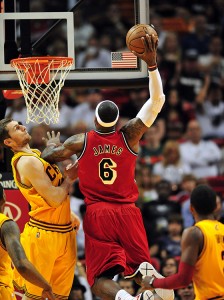 They should have only been outscoring opponents by +6.48/48, but they managed to almost double that to put up +12.35 when on the floor over a 48 minute period. Can you say “blowout?” Thankfully, they only played 194.4 minutes together. This unit was often in towards the ends of games when Dwayne Wade had to rest or wasn’t playing. Having Ray Allen on the floor against lineups that may have been tired might be skewing the effectiveness of this unit. Allen knows how to capitalize on any defensive lapse of perimeter players, and this unit’s success may be a result of that.
They should have only been outscoring opponents by +6.48/48, but they managed to almost double that to put up +12.35 when on the floor over a 48 minute period. Can you say “blowout?” Thankfully, they only played 194.4 minutes together. This unit was often in towards the ends of games when Dwayne Wade had to rest or wasn’t playing. Having Ray Allen on the floor against lineups that may have been tired might be skewing the effectiveness of this unit. Allen knows how to capitalize on any defensive lapse of perimeter players, and this unit’s success may be a result of that.
Conclusions For LeBron’s Lineup Success In Cleveland
There’s a lot that can be said when comparing these lineups, but the main thing to be learned is that LeBron thrives when he is surrounded by players that can make the three ball. That’s actually a little too general. He thrives when the guards around him can make the three ball. Their best lineup featured Allen who shot 37% from behind the arc and Mario Chalmers who shot 38% from behind the arc. Their worst lineup had Norris Cole who only shot 34% from the three line and the only big incapable of shooting the three, Chris Anderson.
The bigs shooting three pointers probably mattered less in the lineups because Battier and Bosh both shot under 35% this season. The variance in three point shooting between the big men was less than that of Wade, Cole, Chalmers, and Allen.
It should be noted that Wade shot an abysmal 28% from behind the three point arc. If I had to ponder why he doesn’t sink the PM/48 of a lineup as much as Cole does, I’d guess it’s because Wade assists on over a quarter of the baskets when he’s playing. Cole only assists on 17%. Also, he’s Dwyane Wade and just knows where to be on the court.
Thankfully, the Cavs have the proper guards to help LeBron succeed. Kyrie Irving only made 35% of his threes this year after making 39% his previous two years, and Dion Waiters made 37% of his threes this year. Kyrie and Dion can both create off the dribble unlike any pairing the Heat played at the guard spots. Don’t forget the Cavs will probably sign LeBron approved spot up shooter Ray Allen and already have LeBron approved spot up man Mike Miller. Nothing will stop LeBron in regard to guard play. There are just too many tools to fix the lineups.
I have an extra unrelated conclusion to share. Chris Bosh deserves his huge contract. The man posts an insanely high PM/48 number, and this study is just further proof that he does whatever is best for the team. Bosh dialed back his game to play with Wade and James; it’s visible on the court when he plays center instead of power forward in the most successful lineup. His season will be a treat to watch, since will be playing up his own skills instead of someone else’s.
Kevin Love, Ricky Rubio, Kevin Martin, Corey Brewer, Gorgui Dieng
This is the worst Love lineup, and it played the second most minutes, 225 . The Wolves should have probably just played four guys instead of this lineup considering they were expected to score +4.14/48 and managed to score -.64/48. Holy terribleness.
Kevin Love, Ricky Rubio, Kevin Martin, Corey Brewer, Dante Cunningham
This lineup was slightly less terrible than the previous one, but it played fewer minutes, 146. While these guys were expected to score +4.32/48 they slightly under-performed and put up +3.62/48. Kevin Love got to be a big boy in this lineup, as he was slotted at center. And, nothing too terrible happened. More on that later.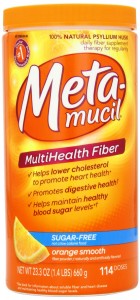
Kevin Love, Ricky Rubio, Kevin Martin, Corey Brewer, Nikola Pekovic
Kevin Love must love Metamucil and the regularity it provides. This lineup played an insane 1052 minutes during the season. That’s up there with teams like the Pacers that utilized their starters to an absurd degree. Kevin thrived from the regularity, and he helped this unit to post +12.41/48. These guys were only expected to be +4.49/48. That’s the biggest over-performance of all of the lineups looked at.
Conclusions For Kevin Love’s Lineup Success In Cleveland
Gorgui Dieng either really sucks or Nikola Pekovic is really good. I wish that was the story because it would be simple and also show that the Wolves were smart playing Dieng so few minutes. That simply wasn’t the case. Dieng rebounded 20% of all the rebounds while Pekovic grabbed 17.6%. Dieng also assisted on 7.2% of plays while turning the ball over 16.8% of the time and blocking 4.6% of shots. Pekovic blocked 1.1% of shots, turned it over 9.4% of time, and assisted on 5.2% of shots. Pekovic’s overall numbers were better than Dieng, but he played a lot more than him. It could be argued that Dieng earned a lot of his high percentages in the above mentioned categories by playing with the second line; after all, there were more rebounds to gobble up when Love wasn’t on the floor. But Dieng’s block percentage and assist percentage really do hold up. Having Kevin Love next to you isn’t helping you pad your block totals in any way, and an assist is an assist. If Dieng played as much as Pekovic did with Kevin Love, their respective units’ actual PM/48 would not have been so different.
All that leads me to conclude that Kevin Love needs the regularity of a consistent lineup. For the Cavs, lineup regularity might become an issue as Anderson Varejao is always getting hurt, and Cleveland has no young durable centers to just slot in for Love to get used to.
The solution to the team’s lack of bigs is small ball! Love played the center spot in the above mentioned lineup with Dante Cunningham on the floor. It wasn’t an overwhelming success and that lineup underperformed, but they were better than the second most used lineup (the Dieng lineup). They also didn’t have as much time to get into the swing of things as the starting 1000 minute lineup did.
The main thing to realize is that Kevin isn’t going to die if he has to play center even though it is sort of common knowledge he doesn’t like to. Furthermore, to use knowledge grabbed from the study of the Heat’s lineups, notice the most successful Heat lineup had Bosh playing center. Bosh is 6’11” and 235 lbs while Kevin Love is 6’10” and 243 pounds. Love came into the league at 260lbs. He can hang out with the big boys and might have to. Bosh did it, and he’s a player who has routinely been referred to as soft/ Bosh Spice. More importantly, Love only allowed centers to earn a PER of 17.7 against him while posting his own PER of 35. That’s not a typo. Bosh posted a PER of 21.6 and allowed the opposing big to grab a PER of 20.4. You can’t go against those numbers. Love can really play center.
Pushing Love to the center spot eliminates the problem of getting a durable center for lineup regularity and enables LeBron to play in his ideal lineup situation, one full of capable shooters. It also keeps the paint open for perimeter players to drive the ball to the hoop. Who knows, Love may even be able to find a happy middle ground weight to play in the paint and on the perimeter comfortably.
Defense
Defense needs to be dealt with by thinking about which roster it may mirror. The Timberwolves weren’t thought of as an amazing defensive team last year. They allowed 104.3 points per game, which was 27th in the league. Miami allowed 97.4 which was sixth. It’s safe to say the Cavs will be looking towards the Heat if they model their defense after another team. LeBron James was also on the Heat and their best defensive player when he needed to be while Kevin Love rarely upped his defense for the Wolves.
The most common starting lineup for the Cavs is probably going to be Kyrie Irving, Dion Waiters, LeBron James, Kevin Love, and Anderson Varejao. Most fans probably don’t think defense is going to come from the guard spot, and they actually think the defense there will be worse than what Miami’s Dwayne Wade and Mario Chalmers/Norris Cole combo provided. This simply won’t be the case.
Kyrie Irving got 1.5 steals per game last season, and Mario Chalmers got 1.6 steals per game. Norris Cole got .9 a game, which is the exact same as Dion Waiters. Dwayne Wade got 1.5 per game, but he was notorious for staying back on possessions to argue with the refs and gave up a lot of points that way. Yes, it has to be acknowledged that Chalmers, Wade, and Cole are better defenders than the Cavs guards currently are. However, before LeBron arrived Chalmers wasn’t thought of as a defender, and he didn’t get as many steals (He had 1.2 per game the year before LeBron came, his steal % has gone up every year he has played with LeBron). Norris Cole didn’t see the floor until he started playing defense.
That’s the LeBron effect and plain old fear of being benched. LeBron is going to help Kyrie and Dion become better defenders, and David Blatt will be able to bench either of them without getting destroyed by the opposition. The ability to bench either of those guys has never existed before; defense has truly never mattered for these two Cavs guards. It’s also important to note that these guards aren’t going to have to play as much offense, which is going leave more energy for defense. On a side note, Dion has the same body type as Wade, which should help him to avoid getting pushed around if guards try to work him into the post.
Looking towards the front-court, it’s so easy to say that Anderson Varejao won’t and can’t do what Chris Bosh did on the defensive end. I actually thought that too before I looked at the numbers. It’s baloney though. Varejao is a regular sideshowasaurous. Bosh didn’t actually protect near the rim. Opponents shot 53.1% at the rim on him, and he allowed 6.9 attempts per game. The Cavs own Varejao allowed opponents to shoot 54.8% at the rim, but he only let players attempt 5.8 shots. These two guys are very similar. Furthermore, Andy is known to jump out too far on the player using a pick (Trevor Magnotti of Fear the Sword details this and much more in his piece about Andy’s defense), which causes him to have trouble recovering. In a Miami-Chris-Bosh style defensive reaction, Anderson would just stay on the man and trap him. He wouldn’t even have to recover, which would play to his strengths. Furthermore, Andy excels at just chasing guys around on the floor, which is quite scary for any guard who has just fumbled his dribble. Would you want the Wild Thing charging you? Would you want to also fear LeBron might be after you too?
One of the things that made the Heat so deadly when they decided to use their terror trapping techniques was that the front court players could all switch onto other guys. This enabled them to switch aggressively and interrupt the points where the ball changed hands. The Cavs are going to have this ability. Kevin Love can theoretically use his length to contain a three while using his size to contain a five. Varejao can deal with power forwards using his speed, and LeBron is a freak who can cover anyone when he wants to.
Some say Kevin Love isn’t a defender, but swapping out Battier for Love is still an upgrade. Here’s the logic. Love is by far more athletic and has more length than Battier (last year’s Battier at least). That’s going to cause more problems in a trapping situation. He may mess up on basic defensive set-ups, but Love is going to have success when he is pushing the defense’s pace onto the opposition. Love also held opposing power forwards to a PER of 14.2 while Battier allowed opponents to post a PER of 18.7; Battier was also letting power forwards earn an effective field goal percentage 5.2% better than what Love allowed. Love isn’t as big of a joke on defense as is commonly thought.
If the Cavs decide to finish games with Shawn Marion instead of Andy, that will push Love to the five spot. This may work even better defensively because Love will get to play against slower centers, and on pick and rolls he will have fantastic help defense nearby.
This Cavs team is going to be running a defense that has players who are either equal to their Miami counter-parts (Anderson Varejao) or have the right tools to be better than their Miami counter-parts. Once they are dialed in they should be able to cause turnovers at the same rate Miami did in their second season.
Crazy Lineup Prediction Time
When the Cavs hit the playoffs, I imagine there will be no 1000 minute lineup like the one Love overachieved with so much on the Wolves, but I can see the Cavs having a lineup that does post 300 minutes in the second half of the season.
It’s the better-heeled son of the Heat’s best lineup. David Blatt plays Kyrie Irving, Dion Waiters, LeBron James, Shawn Marion, and Kevin Love. It is going to be successful if only because it mimics pretty nearly what the Heat had with Allen, Bosh, Chalmers, Battier, and James on the floor. There’s a good chance it might even be superior considering every player that is mentioned is being replaced by someone better. Battier being replaced by Marion could be argued to be a toss-up, but Battier ultimately retired and Marion didn’t. That says something right? Bosh and Love may seem like a wash, but Love’s ability to shoot the ball so well and rebound pushes him ahead of the dinosaur man, as he will help to stretch the opposition’s defense so much more. Defensively, Bosh is ahead of Love currently, but this will be the first season where Love has ever had a reason to play defense. The season needs to play out before any comments about Love’s defense can be made with any certainty. This unit might not necessarily have the defensive ability as one with Varejao in it, but it will make up for that with the amount of offense it creates. A three is always worth more than a two, and there will be five people in this lineup who can prove that all the time.
When the season ends, I’ll do this exercise again and see if it is true that LeBron needs shooters around him and Love needs regularity. It’s going to be weird watching a team that will probably look similar to the Heat in a lot of ways and not having to boo them, but I’m up for the challenge. Stats for this piece came from NBA.com, basketballreference.com, sportingcharts.com, 82games.com, and ESPN.com. Thank you to my fellow Cavs: The Blog bloggers, Nate Smith and Tom Pestak, for all the help with this piece.


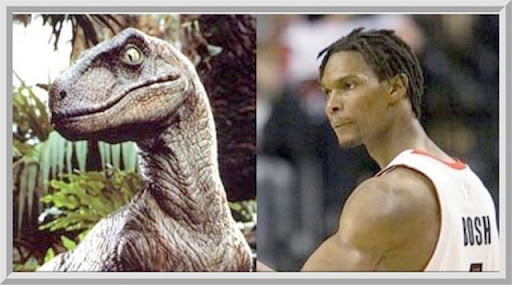
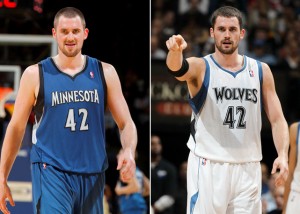
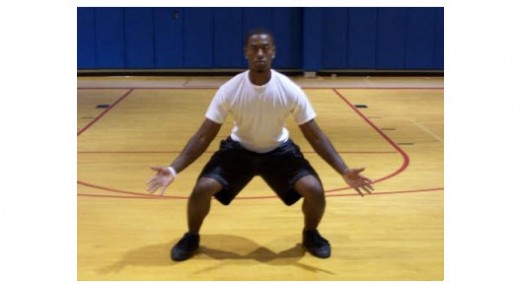


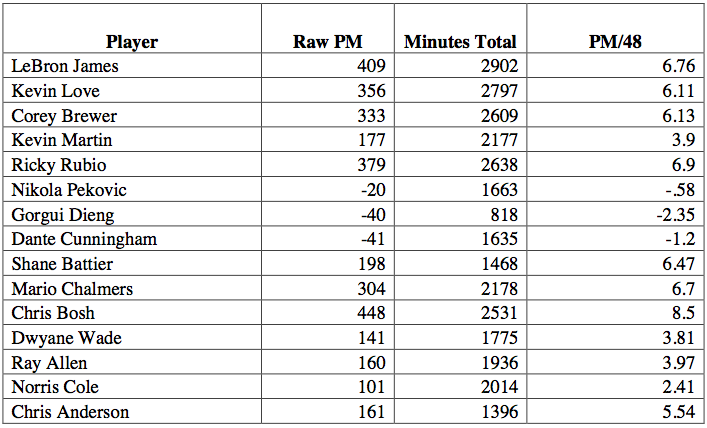
Great article, David. Thanks for taking the time to do all this research
Fun read, but I take issue with reducing guard defense to steal totals, especially when bigs got more useful analytics like PER against. Nobody ever had any problem with Kyrie’s steals which are helped by his incredibly fast hands. It’s been his inability to navigate screens and his lack of overall awareness that have been the biggest detriments to his defense. And a note about Chalmers, as bad as I think he is, I think he was always regarded as a pretty good defender. I booted up NBA 2k9 and he had an A- for perimeter defense in just his… Read more »
Yeah I’d agree with you. Steals aren’t always a great defensive indicator (though they’re a surprisingly good indicator of collegiate to pro talent translation — I think it’s because itis a measure of aggressiveness). Kyrie’s steals numbers seem to indicate he can defend when engaged, but also that he might spend too much time jumping passing lanes. Iverson always had good steal numbers, but a lot of that was because he took so many risks. Some of the best defenders I’ve ever seen have pedestrian steal numbers. Chalmers’ dRAPM numbers were about -.3 to -.5 over the last three seasons,… Read more »
I’d wager a guess that he doesn’t want people to realize that Kyrie allowed a higher PER to opponents than he posted himself last year. I’m not saying that’s the case, but it wouldn’t surprise me in the least.
Good post. Although I don’t think it’s going to be weird at all rooting for the Cavs. Who cares if they do some things the Heat did. The Spurs stole the Heat’s movement and passing and crazy three point shooting offense. Does anyone care? Nope.
This Cavs team is going to be great. They are going to kill everyone. Get used to it.
Obviously, David cares, or he wouldn’t be writing it. Your opinions are not a chorus.
You know, as much as I’d like the Cavs to succeed and win it all this year and have as much fun watching them as possible, your continuous monotonous posts makes me more and more want them to fail and fail badly just to get you to shut up with the same 4 lines you make in every single post of yours in every single new thread. I haven’t even really come to these boards the last 3-4 weeks – I do today and this is the first comment I read. You’re completely dense and one of the worst posters… Read more »
There is nothing wrong with someone being highly enthusiastic.
Cols714 is confident that everything will go right. I am confident a lot of stuff will go right.
I am confident in reminding Cols that: this is Cleveland. In 50 years, nothing has gone supremely right.
Something will go wrong. Something always does. Get used to it.